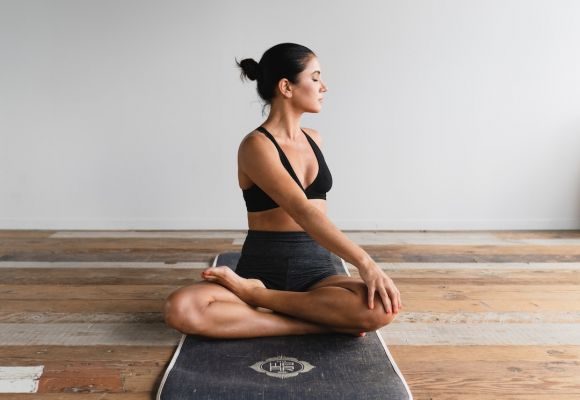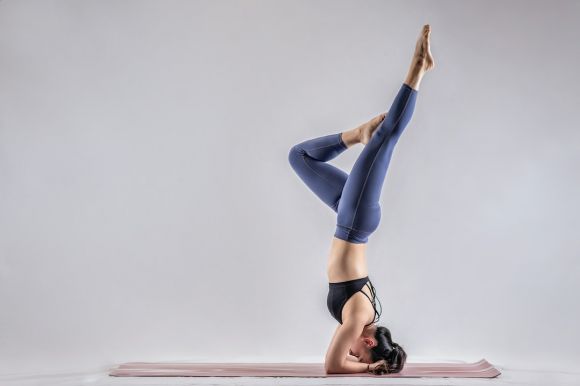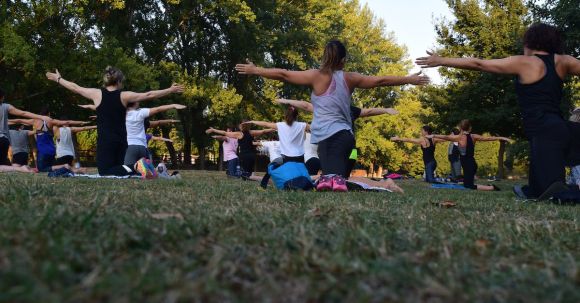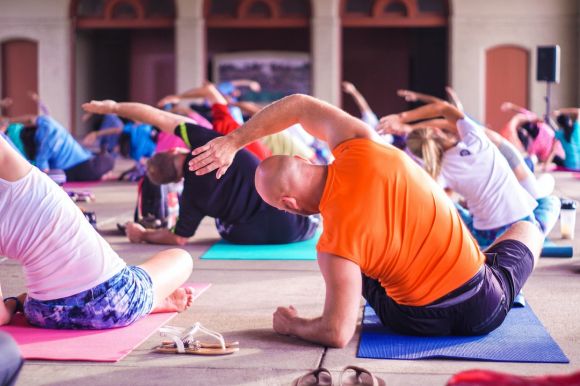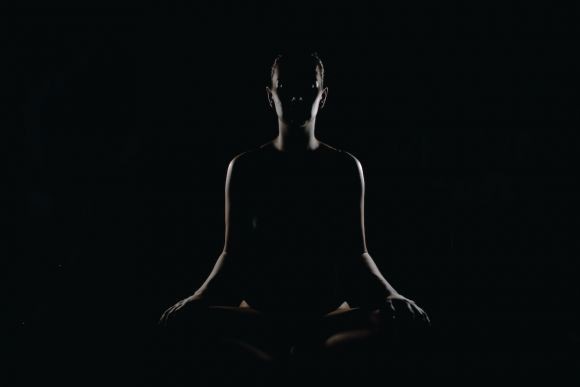In today's fast-paced world, finding time for relaxation and self-care can be challenging. However, incorporating meditation into your daily routine can provide numerous benefits for your mental, emotional, and physical well-being. Meditation allows you to quiet your mind, reduce stress, and increase focus and clarity. If you're unsure about how to get started, here are some helpful tips on how to incorporate meditation into your daily routine.
Yoga and meditation
Good posture is essential for overall health and well-being. Unfortunately, many people today spend long hours sitting at desks or hunched over electronic devices, leading to poor posture and alignment. This can result in aches and pains, decreased flexibility, and even chronic conditions. However, there is a solution – yoga poses can help improve your posture and alignment, allowing you to move more freely and live pain-free.
Strengthen Your Core with Boat Pose
Boat pose, or Navasana, is a great yoga pose for strengthening the core muscles that help support proper posture. To do this pose, sit on the mat with your legs extended in front of you. Lean back slightly, keeping your spine straight, and lift your legs off the ground. Reach your arms forward, parallel to the ground, and hold this position for several breaths. This pose engages the abdominal muscles, helping to improve core strength and stability.Open Up Your Chest with Camel Pose
Camel pose, or Ustrasana, is a wonderful yoga pose for opening up the chest and improving posture. Begin by kneeling on the mat with your knees hip-width apart. Place your hands on your lower back, fingers pointing down. As you inhale, press your hips forward and arch your back, gently tilting your head back. Hold this pose for a few breaths, feeling the stretch in your chest and front of the shoulders. Camel pose helps counteract the hunching forward that often occurs with poor posture, allowing you to stand tall and open.Lengthen Your Spine with Downward Facing Dog
Downward facing dog, or Adho Mukha Svanasana, is a classic yoga pose that stretches and lengthens the spine, helping to improve posture and alignment. Begin on your hands and knees, with your wrists under your shoulders and your knees under your hips. Tuck your toes under and lift your hips up, coming into an inverted V shape. Press your hands into the mat and reach your heels toward the ground. Relax your head and neck, and breathe deeply as you hold this pose. Downward facing dog helps release tension in the back and neck, allowing for better posture and alignment.Align Your Spine with Mountain Pose
Mountain pose, or Tadasana, is a foundational yoga pose that helps align the entire body, from head to toe. Stand tall with your feet hip-width apart and your arms at your sides. Ground down through your feet, engaging the muscles of your legs and lifting through the crown of your head. Roll your shoulders back and down, opening up your chest. Breathe deeply as you hold this pose, feeling the alignment from your feet all the way up to the top of your head. Mountain pose helps improve posture by teaching you how to stand tall and balanced. In conclusion, yoga poses are a powerful tool for improving posture and alignment. Whether you're dealing with aches and pains from poor posture or simply want to move more freely, incorporating these poses into your daily routine can make a significant difference. Strengthening your core, opening up your chest, lengthening your spine, and aligning your entire body are all benefits of practicing yoga. So why not give it a try? Start with these poses and see the positive impact it can have on your posture and overall well-being.
In today's fast-paced world, it can be challenging to stay focused and concentrate on the task at hand. With endless distractions and constant demands for our attention, it's no wonder that many of us struggle to maintain a sharp focus. However, with the practice of meditation, we can train our minds to become more focused and attentive. In this article, we will explore effective meditation techniques that can help improve your focus and concentration.
Developing a Daily Meditation Practice
The first step in improving your focus and concentration through meditation is to establish a daily practice. Set aside a specific time each day to devote to meditation. Start with just a few minutes and gradually increase the duration as you become more comfortable. Consistency is key, so try to practice meditation at the same time and in the same location every day.Focus on Your Breath
One of the fundamental techniques in meditation is to focus on your breath. Sit comfortably in a quiet space and close your eyes. Take a deep breath in through your nose, feeling your belly rise, and then exhale slowly through your mouth. As you breathe, pay close attention to the sensation of the breath entering and leaving your body. Whenever your mind starts to wander, gently bring your focus back to your breath. This simple practice can help calm your mind and improve your ability to concentrate.Body Scan Meditation
Another effective technique for improving focus and concentration is body scan meditation. Start by sitting or lying down in a comfortable position. Close your eyes and bring your attention to your body. Begin at the top of your head and slowly scan down to your toes, noticing any sensations or areas of tension. As you become more aware of your body, you'll find that your mind becomes more grounded and focused.Mindfulness Meditation
Mindfulness meditation is a practice that involves bringing your full attention to the present moment. Sit in a comfortable position and focus on your breath, just as you would in breath-focused meditation. However, instead of solely focusing on your breath, expand your awareness to include any thoughts, feelings, or sensations that arise. Without judgment or attachment, simply observe these experiences and let them pass. This practice can help train your mind to stay present and decrease distractions.Loving-Kindness Meditation
Loving-kindness meditation is a powerful technique for cultivating compassion and improving focus. Sit comfortably and bring to mind someone you care about deeply. Repeat a series of phrases such as "May you be happy. May you be healthy. May you live with ease." As you continue to repeat these phrases, extend your well-wishes to yourself, loved ones, acquaintances, and even those with whom you have difficulties. This practice can help shift your focus from distractions to positive intentions.The Benefits of Improved Focus and Concentration
By incorporating meditation techniques into your daily routine, you can experience a range of benefits beyond improved focus and concentration. Regular meditation practice has been shown to reduce stress, enhance emotional well-being, and increase self-awareness. Additionally, it can improve memory, boost creativity, and promote overall mental clarity.Conclusion
Improving your focus and concentration is a valuable skill that can positively impact various aspects of your life. Through the practice of meditation, you can train your mind to become more attentive and present. By developing a daily meditation practice, focusing on your breath, practicing body scan and mindfulness meditation, as well as engaging in loving-kindness meditation, you can enhance your ability to stay focused amidst distractions. Start small and be patient with yourself as you embark on this journey of self-improvement. With consistent effort and practice, you'll soon reap the rewards of a more focused and concentrated mind.
Yoga is not just a physical exercise; it is a holistic practice that benefits both the mind and body. One of the major advantages of practicing yoga is the improvement in flexibility and mobility. Yoga flows, a sequence of yoga poses linked together in a continuous movement, are particularly effective in enhancing flexibility and mobility. In this article, we will explore how yoga flows can help you increase your flexibility and mobility, and provide some examples of yoga flows that you can incorporate into your practice.
Understanding the Importance of Flexibility and Mobility
Flexibility refers to the range of motion in your joints and muscles, while mobility refers to the ability to move freely and easily. Both flexibility and mobility are essential for maintaining proper posture, preventing injuries, and performing daily activities with ease. Unfortunately, due to our sedentary lifestyle and lack of movement, many of us have limited flexibility and mobility. This is where yoga flows come in.The Benefits of Yoga Flows
Yoga flows are designed to gently stretch and strengthen your muscles, improving both flexibility and mobility. Unlike static stretching, where you hold a pose for a certain period, yoga flows involve continuous movement, which helps to warm up the muscles and increase blood flow. This dynamic approach not only enhances flexibility but also improves balance, coordination, and body awareness.Example Yoga Flows
1. Sun Salutation Flow: Start in Mountain Pose, inhale and raise your arms overhead, exhale and fold forward into Forward Fold. Inhale and lift halfway, exhale and step back into Plank Pose. Lower down into Chaturanga, inhale and lift into Upward Facing Dog, exhale and lift your hips into Downward Facing Dog. Repeat this flow several times, synchronizing your breath with the movement. 2. Warrior Flow: Begin in Mountain Pose, step your left foot back into Warrior I. Inhale and lift your arms overhead, exhale and open your hips into Warrior II. Inhale and straighten your front leg, exhale and hinge forward into Triangle Pose. Repeat on the other side, flowing between Warrior I, Warrior II, and Triangle Pose. 3. Seated Flow: Start in a seated position with your legs extended in front of you. Inhale and reach your arms overhead, exhale and fold forward into Seated Forward Bend. Inhale and sit up, exhale and twist to the right, placing your left hand on your right knee and your right hand behind you. Inhale and come back to the center, exhale and twist to the left. Repeat this flow several times, allowing your breath to guide your movement.Incorporating Yoga Flows into Your Practice
To effectively increase flexibility and mobility, it is important to practice yoga flows regularly. Start by incorporating one or two flows into your routine and gradually increase the number as you become more comfortable. Remember to listen to your body and modify the poses as needed. It is also beneficial to attend yoga classes or seek guidance from a qualified yoga instructor to ensure proper alignment and prevent injuries.Conclusion: Embrace the Flow
Flexibility and mobility are not only essential for physical well-being but also contribute to overall health and vitality. By incorporating yoga flows into your practice, you can gradually increase your range of motion, improve posture, and enhance body awareness. Embrace the flow and experience the transformative power of yoga in your life.
In today's fast-paced world, finding ways to relax and reduce stress is more important than ever. One popular method that has gained traction in recent years is the practice of yoga and meditation. Not only does it help to calm the mind and improve focus, but it also provides numerous physical benefits such as increased flexibility and strength. If you're interested in starting a yoga and meditation routine but don't know where to begin, this article will guide you through the process.
Understanding the Basics
Before diving into the world of yoga and meditation, it's essential to understand the basics. Yoga is an ancient practice that combines physical postures, breathing techniques, and meditation to promote overall well-being. Meditation, on the other hand, is a practice that involves focusing the mind and achieving a state of deep relaxation and mental clarity. Both practices go hand in hand and complement each other perfectly.Setting Your Goals
The first step in starting a yoga and meditation routine is to set your goals. What do you hope to achieve through this practice? Are you looking to reduce stress, increase flexibility, or improve your overall well-being? By identifying your goals, you can tailor your routine to meet your specific needs. Remember, everyone's journey is unique, so it's important to focus on what you want to achieve rather than comparing yourself to others.Finding a Suitable Space
Creating a peaceful and dedicated space for your yoga and meditation practice is crucial. Look for a quiet area in your home where you can set up a yoga mat or meditation cushion. It should be free from distractions and have enough room for you to move comfortably. Consider adding elements that promote relaxation, such as candles, incense, or calming music. This designated space will help you establish a routine and make it easier to disconnect from the outside world.Starting with Simple Poses and Techniques
As a beginner, it's essential to start with simple yoga poses and meditation techniques. Trying to tackle advanced postures and deep meditation right from the start can be overwhelming and discouraging. Begin by practicing basic poses such as child's pose, downward dog, and mountain pose. These poses will help you build strength, flexibility, and body awareness. When it comes to meditation, start with short sessions of five to ten minutes and gradually increase the duration as you become more comfortable.Creating a Routine
Consistency is key when it comes to establishing a yoga and meditation routine. Set aside a specific time each day for your practice, whether it's in the morning, during lunch breaks, or in the evening. Having a regular schedule will make it easier to develop a habit and ensure that you prioritize your practice. Remember, even a few minutes of yoga and meditation each day can make a significant difference in your overall well-being.Seeking Guidance
If you're new to yoga and meditation, seeking guidance from an experienced instructor can be incredibly beneficial. Consider taking a beginner's yoga class or joining a meditation group in your area. These resources will provide you with proper guidance and help you avoid common mistakes. Additionally, learning from others can inspire and motivate you to continue your practice.Conclusion: Embracing a New Lifestyle
Starting a yoga and meditation routine is a journey of self-discovery and personal growth. By understanding the basics, setting goals, creating a suitable space, starting with simple poses and techniques, establishing a routine, and seeking guidance, you can embark on this transformative path. Remember to be patient with yourself, listen to your body, and enjoy the process. Embrace this new lifestyle and watch as it positively impacts your physical, mental, and emotional well-being.
Yoga is a practice that goes beyond physical exercise. It is a way of life that encompasses not only the body, but also the mind and spirit. One of the fundamental teachings of yoga philosophy is the cultivation of self-acceptance and compassion. By embracing these principles, we can transform our relationship with ourselves and others, leading to a more fulfilling and meaningful existence.
Understanding Self-acceptance
Self-acceptance is the ability to fully embrace and love oneself, flaws and all. It is about recognizing that we are imperfect beings and that it is okay to make mistakes. In yoga philosophy, self-acceptance is rooted in the concept of Svadhyaya, or self-study. By observing ourselves without judgment, we can gain insight into our patterns, behaviors, and beliefs, and learn to accept ourselves just as we are.Practicing self-acceptance on the mat
Yoga provides a safe space for us to practice self-acceptance. As we move through the poses, we may encounter physical limitations or challenges. Instead of pushing ourselves to achieve a certain shape or level of flexibility, we can learn to honor our bodies and meet ourselves where we are. Through this practice, we can cultivate self-compassion and let go of the need for external validation.Extending compassion to others
Compassion is an essential component of yoga philosophy. It is the ability to empathize with others and respond with kindness and understanding. By cultivating self-acceptance, we can extend this compassion to others. When we fully accept ourselves, we are better able to accept others as well, embracing their strengths and weaknesses. This allows us to build deeper connections and foster a sense of community and belonging.Practicing compassion off the mat
The practice of compassion extends far beyond the confines of a yoga mat. In our daily lives, we encounter various situations that test our ability to respond with kindness and understanding. By cultivating self-acceptance, we become more aware of our own emotions and triggers, allowing us to respond to others with greater empathy. This can be as simple as offering a listening ear to a friend in need or volunteering our time to help those less fortunate.The power of mindfulness
Mindfulness is another key aspect of yoga philosophy that contributes to the development of self-acceptance and compassion. By practicing mindfulness, we become more present in the moment, fostering a greater awareness of our thoughts, feelings, and actions. This awareness allows us to respond to ourselves and others with greater compassion, as we are better able to understand and acknowledge our own suffering and that of others.Integrating self-acceptance and compassion into everyday life
Cultivating self-acceptance and compassion is an ongoing process that requires daily practice and mindfulness. It is about being patient with ourselves and recognizing that change takes time. By incorporating simple practices such as self-reflection, gratitude, and acts of kindness into our daily routines, we can gradually transform our relationship with ourselves and others.In conclusion
Yoga philosophy offers valuable teachings on self-acceptance and compassion. By embracing these principles, we can cultivate a deep sense of self-love and extend that love to others. Through the practice of yoga, both on and off the mat, we can transform our lives and create a more compassionate and accepting world. So, let us embark on this journey of self-discovery and embrace the power of self-acceptance and compassion through the wisdom of yoga philosophy.
Yoga is more than just a form of exercise; it is a holistic practice that benefits both the body and the mind. While many people associate yoga with flexibility and stress relief, it also offers numerous benefits for strengthening muscles and improving balance. Whether you are a seasoned yogi or a beginner, incorporating yoga into your fitness routine can enhance your overall physical well-being. In this article, we will explore how yoga can help you build stronger muscles and improve your balance.
Muscle Strengthening through Yoga
Yoga poses, or asanas, require you to engage and hold various muscle groups. By practicing these poses regularly, you can develop stronger and more toned muscles throughout your body. Unlike traditional weightlifting exercises that isolate specific muscles, yoga engages multiple muscle groups simultaneously, resulting in a more functional and balanced physique. One example of a yoga pose that targets multiple muscle groups is the Plank pose. This pose primarily works your core muscles, including your abdominals, obliques, and lower back. Additionally, it engages your arms, shoulders, and leg muscles to maintain stability and balance. Holding this pose for an extended period strengthens your muscles and improves their endurance. Another yoga pose that contributes to muscle strengthening is the Warrior II pose. This pose targets your leg muscles, including your quadriceps, hamstrings, and calves. It also engages your core muscles for stability and your arms and shoulders for balance. Practicing Warrior II regularly will help build strength and stability in your lower body.Balancing through Yoga
Balance is a crucial aspect of physical fitness that often gets overlooked. However, balance training is essential for preventing injuries and maintaining stability as we age. Yoga poses inherently challenge your balance by requiring you to hold positions that test your body's equilibrium. One yoga pose that enhances balance is the Tree pose. In this pose, you stand on one leg while placing the sole of your opposite foot on your inner thigh or calf. This pose strengthens your leg muscles and improves your ability to balance. As you progress in your practice, you can challenge yourself further by closing your eyes or extending your arms overhead. The Eagle pose is another yoga asana that improves balance. This pose involves crossing one leg over the other and wrapping one arm under the other, creating a twisted shape. By practicing the Eagle pose regularly, you can enhance your balance and stability, particularly in your legs and core.Conclusion: Embrace the Benefits of Yoga
Incorporating yoga into your fitness routine can offer numerous benefits, including muscle strengthening and improved balance. Unlike traditional forms of exercise, yoga provides a holistic approach that engages multiple muscle groups and challenges your equilibrium. By regularly practicing yoga poses that target these areas, such as the Plank, Warrior II, Tree, and Eagle poses, you can build stronger muscles and improve your balance over time. So, if you are looking to enhance your physical well-being, consider adding yoga to your fitness repertoire. Not only will you experience the benefits of increased strength and improved balance, but you will also enjoy the mental and emotional benefits that come with this ancient practice. Strengthen your muscles and find your balance through yoga, and watch as your overall fitness and well-being reach new heights.
In today's fast-paced and often stressful world, it is important to find ways to cultivate gratitude and self-love. Yogic philosophy offers valuable insights and practices that can help us achieve these goals. By embracing the principles of gratitude and self-love, we can experience greater inner peace, happiness, and overall well-being. Let us explore how yogic philosophy can guide us on this transformative journey.
Embracing Gratitude
Gratitude is a powerful emotion that allows us to appreciate the beauty and abundance in our lives. Yogic philosophy teaches us to cultivate gratitude by focusing on the present moment and acknowledging the blessings we have. By practicing gratitude, we shift our perspective from scarcity to abundance, from negativity to positivity. One way to embrace gratitude is through the practice of mindfulness. By being fully present in each moment, we become aware of the many things we can be grateful for - the warmth of the sun, the sound of birds chirping, the love of our friends and family. Mindfulness helps us cultivate a sense of awe and appreciation for the simple joys that surround us. Another yogic practice that promotes gratitude is the practice of seva, or selfless service. By helping others and giving back to our communities, we develop a deep sense of gratitude for the opportunities we have and the ability to make a positive impact on the world. Through seva, we recognize our interconnectedness and the countless ways in which we are supported by others.Nurturing Self-love
Self-love is the foundation of a healthy and fulfilling life. It is about accepting ourselves as we are, with all our strengths and weaknesses, and treating ourselves with kindness, compassion, and respect. Yogic philosophy teaches us that self-love is not selfish or egotistical, but rather an essential aspect of our growth and well-being. One of the key principles of self-love in yogic philosophy is ahimsa, or non-violence. Ahimsa involves treating ourselves with kindness and compassion, and refraining from self-criticism and self-judgment. By practicing ahimsa towards ourselves, we create a nurturing and supportive inner environment, which allows us to flourish and grow. Yogic philosophy also emphasizes the importance of self-care. Taking care of our physical, mental, and emotional well-being is an act of self-love. This can include practicing yoga asanas, engaging in meditation, eating nourishing foods, getting enough rest, and engaging in activities that bring us joy and relaxation. By prioritizing self-care, we send a message to ourselves that we are deserving of love, care, and attention.The Transformative Journey
Cultivating gratitude and self-love is a journey that requires consistent practice and self-reflection. It is not something that happens overnight, but rather a gradual process of growth and transformation. Along this journey, we may encounter obstacles and setbacks, but by embracing the teachings of yogic philosophy, we can navigate these challenges with grace and resilience. As we cultivate gratitude and self-love, we begin to experience a profound shift in our perception of ourselves and the world around us. We become more resilient in the face of adversity, more compassionate towards ourselves and others, and more attuned to the beauty and abundance in our lives. We begin to embrace our authentic selves and live in alignment with our true values and purpose. In conclusion, yogic philosophy provides valuable guidance and practices for cultivating gratitude and self-love. By embracing these principles, we can experience greater inner peace, happiness, and overall well-being. The journey towards gratitude and self-love is transformative, requiring consistent practice and self-reflection. However, the rewards are immeasurable - a more fulfilling and meaningful life, grounded in love and appreciation. Let us embark on this transformative journey and cultivate gratitude and self-love through the wisdom of yogic philosophy.
In today's fast-paced world, it is easy to get caught up in the hustle and bustle of everyday life. We often find ourselves juggling multiple tasks, constantly striving to achieve success and meet the demands of our personal and professional lives. In the midst of this chaos, we often overlook the power of our own minds and the role they play in shaping our reality. However, through the practice of yoga and meditation, we can tap into the immense potential of our minds and unlock a whole new level of clarity, focus, and inner peace.
The Mind-Body Connection
The mind and body are intricately connected, and any imbalance in one affects the other. Yoga and meditation are ancient practices that help align the mind and body, creating a harmonious connection that allows us to function at our best. By combining physical poses, breath control, and meditation techniques, yoga helps us cultivate a state of mindfulness and awareness. This heightened state of consciousness allows us to understand and control our thoughts, emotions, and reactions, leading to improved mental and physical well-being.Cultivating Inner Peace
One of the greatest benefits of yoga and meditation is their ability to cultivate inner peace. In our fast-paced lives, it is easy to become overwhelmed by stress, anxiety, and negative emotions. However, through regular practice, we can learn to quiet the mind, let go of unnecessary worries, and find peace within ourselves. By focusing on the present moment and letting go of attachments to the past or worries about the future, we can experience a sense of calm and tranquility that extends beyond our yoga mat and into our daily lives.Enhancing Focus and Concentration
In a world filled with distractions, maintaining focus and concentration can be a challenge. Yoga and meditation provide powerful tools to enhance our ability to concentrate and stay focused. The physical postures in yoga require us to be fully present in our bodies, cultivating a sense of body-mind awareness. Through meditation, we learn to direct our attention to a single point of focus, such as the breath or a mantra, training the mind to stay focused and calm. These practices not only improve our ability to concentrate during yoga and meditation but also in our everyday tasks, leading to increased productivity and success.Unleashing Creativity and Intuition
Yoga and meditation have long been associated with heightened creativity and intuition. As we cultivate a deep sense of awareness and presence through these practices, our minds become more open and receptive to new ideas and insights. The stillness and silence we experience in meditation create a fertile ground for creativity to flourish. By quieting the chatter of our minds, we tap into the wisdom of our intuition, allowing us to make better decisions and navigate life with greater clarity and purpose.Embracing Self-Discovery and Personal Growth
Yoga and meditation are not just physical exercises; they are transformative practices that facilitate self-discovery and personal growth. Through the process of self-reflection and introspection, we gain a deeper understanding of ourselves - our strengths, weaknesses, desires, and fears. This self-awareness allows us to make conscious choices, break free from limiting beliefs, and step into our true potential. As we continue to explore and expand our boundaries on the mat, we also expand our horizons off the mat, opening ourselves up to new possibilities and a more fulfilling life.Conclusion: Embrace the Power Within
In a world that often pulls us in a thousand different directions, it is essential to remember the power that lies within us. Through the practice of yoga and meditation, we can harness the power of our minds and unlock our true potential. By cultivating inner peace, enhancing focus, unleashing creativity, and embracing self-discovery, we can navigate life with greater clarity, purpose, and joy. So, take a deep breath, step onto your mat, and allow yourself to tap into the incredible power that resides within you.
In today's fast-paced world, finding inner peace can seem like an elusive goal. The constant demands of work, family, and other responsibilities can leave us feeling overwhelmed and disconnected from ourselves. However, there is a powerful combination of practices that can help us find the peace and serenity we long for: yoga and meditation.
